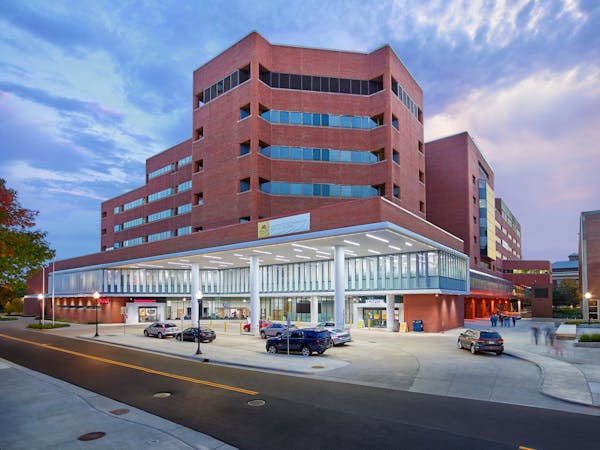Sanford and Fairview executives say the University of Minnesota could always repurchase its teaching hospital in Minneapolis if the U isn't supportive of a mega-merger between the two health systems.
Bill Gassen, the CEO at Sioux Falls-based Sanford Health, floated the idea Tuesday evening in St. Paul at the first of four public meetings about the proposed merger held by Minnesota Attorney General Keith Ellison.
The health systems have been talking with the U since August and want the partnership to continue, Gassen said. But, he said, all options are on the table.
"This includes an option for the University of Minnesota to repurchase the academic medical system from the combined system," Gassen said. "Ultimately, it is the University of Minnesota's decision to make."
Fairview acquired the University of Minnesota Medical Center in 1997, when the teaching hospital was struggling financially.
With the public comments Tuesday, Sanford and Fairview showed their willingness to move the deal forward with or without the university, where leaders started voicing concerns last year.
The current proposal would create a health system with some 78,000 employees. It would be based in South Dakota and operate more than 50 hospitals, including the University of Minnesota Medical Center.
While a crowd of more than 100 people at Tuesday's meeting listened quietly to Gassen, they applauded loudly when Dr. Jakub Tolar, dean of the University of Minnesota Medical School, raised critical questions about the merger proposal.
Tolar said the deal, as currently put forward by Sanford and Fairview, treats the university and its academic medicine mission as a side issue rather than a central component of the merger. He urged Ellison, state legislators and the public to instead focus on what the combination would mean for teaching, research and patient care at the U.
"We are here today to ask you not to advance this combination until Fairview and Sanford work with the university [to] address and resolve how we will continue to use all of our public resources in service to Minnesota," Tolar said. "... It is our view that because the flagship medical facilities on our campus are a part of this proposed acquisition, that what you have in front of you is not a private transaction but a public question for the future for public academic medicine in Minnesota."
He added: "Sanford and Fairview developed their proposed business merger without involving the university. We are not a party to the planning of this merger and so we cannot provide assurance to you and the public, that the public purpose will be fulfilled."
Sanford Health and Minneapolis-based Fairview Health Services tried a merger in 2013, but state political concerns squashed the deal.
Fairview and the U jointly market medical services under the brand M Health Fairview. University physicians treat patients through Fairview's network of hospitals. This year, Fairview is providing more than $83 million to support the U's health care mission, which includes teaching, research and patient care.
In December, the University of Minnesota's president and Board of Regents chair raised concerns about the proposed merger, which they described as driven by financial interests.
Fairview reported an operating loss of $248.5 million through the first nine months of last year. The health system has had several years of operating losses that correspond with increased financial contributions to the U. But university officials have pushed back against any suggestion that the affiliation has been driving Fairview's financial woes.
In a memo to employees Tuesday afternoon, Fairview CEO James Hereford said the idea of the U repurchasing its teaching hospital is just one of many options being discussed and no decisions have been made.
"We appreciate that such an outcome would have implications for many teams in our system," Hereford said in the memo.
If the U wanted to buy the medical center, it would require negotiations to determine a fair market value, according to a Fairview spokesman.
But in a statement Tuesday to the Star Tribune, the university indicated the original sale agreement does not give the U a right to buy back the hospital in the event of a merger or other change of control at Fairview. So, there are no contract terms that would require establishing a fair market value, the U said.
"With charitable assets held by a Minnesota nonprofit, the primary question is not ownership, but rather the charitable purpose to which they are devoted — in this case, the delivery of care by the University of Minnesota and [University of Minnesota Physicians] to patients," the U said in the statement. "That purpose is reflected in the public funds that built the hospital and the academically-affiliated care provided since 1997."
Ellison's review of the merger proposal includes whether it complies with state law on charitable assets as well as any impacts on competition. It was the only meeting for input in the Twin Cities; the next three are scheduled this month for greater Minnesota.
Sanford has said that if the merger goes through as planned this year, it is prepared — absent a new agreement — to keep funding academic medicine at the U until the current long-term deal with Fairview expires at the end of 2026. What happens after that, however, is one of the big unanswered questions with the proposed merger.
Since it was announced in November, unionized health care workers have raised concerns about the merger.
Just before Tuesday evening's meeting at a state Department of Revenue building near the Capitol, leaders and members of four labor groups spoke out in opposition. The groups holding the news conference were SEIU Healthcare Minnesota & Iowa, Minnesota Nurses Association, Minnesota Farmers Unions and MN AFL-CIO.
